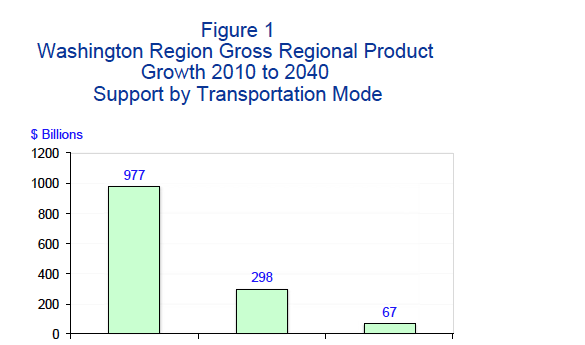Mason transportation study receives criticism from smart growth group
A new study by the George Mason Center for Regional Analysis has received criticism from smart growth advocates who believe the study’s results put too much emphasis on road construction as a means for economic growth.
In early October of 2012, the CRA released a study that measured which forms of transportation would help lead to economic growth in the area.
The study projects that by 2040, $977 billion dollars in Gross Regional Product (GRP) will come from automobile use, $298 billion will be from transit, and $67 billion will be from biking and walking.
“The Washington region is projected to have significant potential economic growth over the next thirty years,” read the study. “Of the GRP growth, almost 3/4 will be in locations where autos provide the accessibility.”
George Mason’s Center for Regional Analysis was formed in 1993. The center’s mission is “to provide research and analytical services to local government and businesses in the Washington region focusing on economic, demographic, transportation, housing and fiscal trends and forecasts.”
“The GMU report is based on flawed and outdated assumptions and would lead our region down an unsustainable development path,” Steward Schwartz, executive director of the Coalition for Smarter Growth, wrote in an Oct. 11 press release.
Founded in 1997, the Coalition for Smarter Growth works to “ensure that transportation and development decisions accommodate growth while revitalizing communities, providing more housing and travel choices, and conserving our natural and historic areas.”
“The report ignored the fundamental shifts in real estate demand, changing demographics and market demand,” said Chery Cort, policy director for the coalition. “The GMU view would also leave behind Prince George’s and older parts of eastern Fairfax and eastern Prince William counties.”
The study looked at the District of Colombia, five Maryland suburbs, and ten counties and cities in Northern Virginia. Currently, Fairfax County is the second largest contributor to GRP at 22.1 percent, second only to the District of Colombia at 25 percent. However, the study predicts that by 2040, Fairfax County will be the leading contributor to the area’s economic growth.
“Economic activity within the Washington region is enabled by transportation connections,” read the study. “The transportation system enables economic activity and economic growth over time. Where, how much, and what types of transportation infrastructure improvements are made enable economic activity in different locations and centers in the metro area.”
The study points to data that shows which modes of transportation commuters take back and forth to work. Over the past 20 years, the number of people using automobiles, transit, and biking or walking has changed by only a few percentage points. As of 2010, 77 percent of Washington area commuters continue to use automobiles.
In the press release, the Coalition for Smarter Growth claimed that making projections on current trends “ignores fundamental changes in the residential real estate market.”
“The report relies on population projections which continue to include old assumptions about growth in the region’s outer suburbs and still don’t fully reflect the dramatic long-term shift in real estate demand,” read the press release. “Demand for housing with long commutes has collapsed and may never recover given high gas prices, the ever-smaller percentage of households with children, and the strong demand of Millennials, retiring Baby Boomers and empty nesters to live in walkable, urban and transit-oriented communities.”
Though reliance on automobiles is not projected to change substantially over the next 30 years, this may not be the case for Fairfax County. According to the study, Fairfax County will have the largest drop in economic growth as a result of automobile use, with a 5.5 percentage point drop from 92.5% in 2010 to 87.1% in 2040. According to the study, this reflects the new Metro service to Tysons Corner and Reston/Dulles.”
The Coalition for Smarter Growth also questioned the merits of the study since it was prepared for the 2030 Group, an organization of Washington area business leaders that researches about economics, population and transportation in the area sponsored it.
“We reject this effort by the 2030 Group through the GMU report...to promote massive new spending on roads and sprawl,” said Schwartz. “We share the goal of an economically competitive region and we are certain that this will require a primary focus on transit and efficient transit-oriented communities.”

